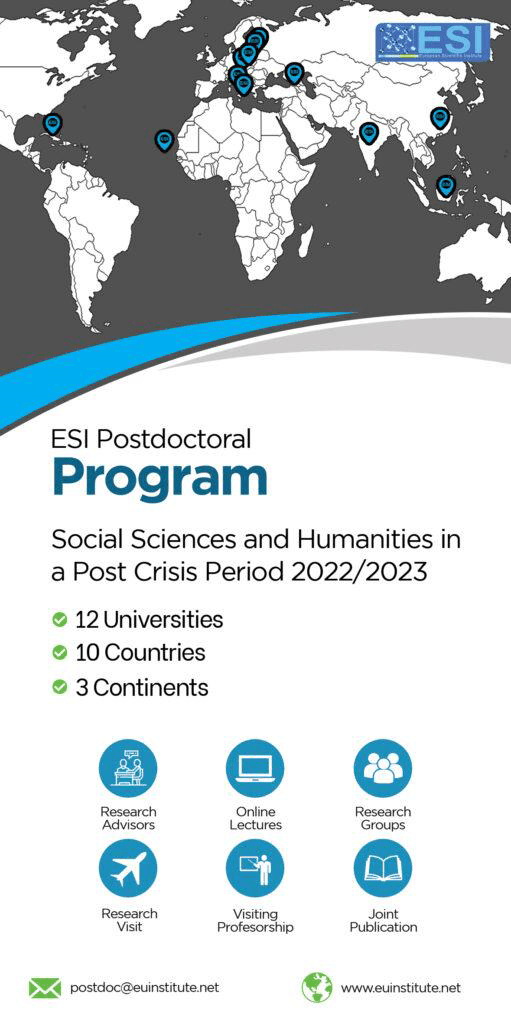The Relationship Between Intrinsic Religiosity and Resilience Among Tunisian Female University Students
Abstract
This study examines the relationship between intrinsic religiosity and resilience among Tunisian female university students. To achieve this objective, a sample of 244 participants was selected using a self-report method. Participants completed measures assessing intrinsic religiosity and resilience, and the data were analyzed using correlation and linear regression analyses. The results showed a statistically significant, albeit modest, positive correlation between intrinsic religiosity and resilience (p < .001). Furthermore, linear regression analysis showed that intrinsic religiosity accounted for a small but meaningful proportion of the variance in resilience scores (R² = 0.055, p < .001). Based on these findings, it is reasonable to conclude that an increase in intrinsic religiosity contributes to fostering resilience, although this relationship remains modest and is influenced by other unexamined factors. The implications of these findings are discussed in light of the cultural and religious contexts in Tunisia, highlighting the need for further research to explore additional psychological and social factors that may influence this relationship. Finally, this study contributes to the growing body of research on psychological resilience in non-Western, predominantly Muslim contexts, where religiosity may function as a culturally relevant coping mechanism.
Downloads
Metrics
PlumX Statistics
References
2. Abdel-Khalek, A. M., & Tekke, M. (2019). The association between religiosity, well-being, and mental health among college students from Malaysia. Revista Mexicana de Psicología, 36(1), 5-16. https://psycnet.apa.org/record/2019-14415-001
3. Allport, G. W. (1963). Behavioral Science, Religion, and Mental Health. Journal of Religion and Health, 2(3), 187-197. http://dx.doi.org/10.1007/BF01533333
4. Allport, G. W., & Ross, J. M. (1967). Personal religious orientation and prejudice. Journal of Personality and Social Psychology, 5(4), 432-443. http://dx.doi.org/10.1037/h0021212
5. Allport, G. W. (1969). The Person in Psychology: Selected Essays (2nd ed.). Beacon Press.
6. Allport, G. W. (1971). Personality: A Psychological Interpretation (3rd ed.). Constable.
7. Burnett, H. J., Jr, & Helm, H. W., Jr (2013). Relationship between posttraumatic stress disorder, resilience, and religious orientation and practices among university student earthquake survivors in Haiti. International journal of emergency mental health, 15(2), 97-104. http://digitalcommons.andrews.edu/behavioral-pubs/15
8. Connor, K. M., & Davidson, J. R. T. (2003). Development of a new Resilience scale: The Connor-Davidson Resilience scale (CD-RISC). Depression and Anxiety, 18(2), 76-82. https://doi.org/10.1002/da.10113
9. Cohen, A. B., Hall, D. E., Koenig, H. G., & Meador, K. G. (2005). Social Versus Individual Motivation: Implications for Normative Definitions of Religious Orientation. Personality and Social Psychology Review, 9(1), 48-61. https://doi.org/10.1207/s15327957pspr0901_4
10. Connor, K. M., Davidson, J. R., & Lee, L. C. (2003). Spirituality, resilience, and anger in survivors of violent trauma: a community survey. Journal of traumatic stress, 16(5), 487-494. https://doi.org/10.1023/A:1025762512279
11. Derouiche-El Kamel, S., & Hentati, Y. (2021). Portrait of resilience among Tunisians locked down in times of COVID-19. Traumatology, 27(1), 70-77. https://doi.org/10.1037/trm0000300
12. Dolcos, F., Hohl, K., Hu, Y., & Dolcos, S. (2021). Religiosity and Resilience: Cognitive Reappraisal and Coping Self-Efficacy Mediate the Link between Religious Coping and Well-Being. Journal of religion and health, 60(4), 2892-2905. https://doi.org/10.1007/s10943-020-01160-y
13. Erdogan, E., Ozdogan, O., & Erdogan, M. (2015). University Students’ Resilience Level: The Effect of Gender and Faculty. Procedia-Social and Behavioral Sciences, 186, 1262-1267. https://doi.org/10.1016/j.sbspro.2015.04.047
14. Fiori, K. L., Brown, E. E., Cortina, K. S., & Antonucci, T. C. (2006). Locus of control as a mediator of the relationship between religiosity and life satisfaction: Age, race, and gender differences. Mental health, religion & culture, 9(3), 239-263. https://doi.org/10.1080/13694670600615482
15. Fortier, C. (2005). Infléchir le destin car la vraie souffrance est à venir. Systèmes de pensée en Afrique noire, 17, 195-217. https://doi.org/10.4000/span.736
16. Foster, K., Roche, M., Delgado, C., Cuzzillo, C., Giandinoto, J. A., & Furness, T. (2019). Resilience and mental health nursing: An integrative review of international literature. International journal of mental health nursing, 28(1), 71-85. https://doi.org/10.1111/inm.12548
17. Francis, L. J., Robbins, M., & White, A. (2003). Correlation between religion and happiness: A replication. Psychological Reports, 92(1), 51-52. https://doi.org/10.2466/pr0.2003.92.1.51
18. Francis, L. J., Tekke, M., & Robbins, M. (2016). The psychometric properties of the Sahin-Francis Scale of Attitude towards Islam revised among Sunni students in Malaysia. Mental Health, Religion & Culture, 19(5), 433-439. https://doi.org/10.1080/13674676.2016.1193480
19. French, S., & Joseph, S. (1999). Religiousness and its association with happiness, purpose in life, and self-actualisation. Mental Health, Religion & Culture, 2(2), 117-120. https://doi.org/10.1080/13674679908406340
20. Frounfelker, R. L., Tahir, S., Abdirahman, A., & Betancourt, T. S. (2020). Stronger together: Community resilience and Somali Bantu refugees. Cultural Diversity and Ethnic Minority Psychology, 26(1), 22–31. https://doi.org/10.1037/cdp0000286
21. Gan, S. K., Wong, S. W., & Jiao, P. D. (2023). Religiosity, Theism, Perceived Social Support, Resilience, and Well-Being of University Undergraduate Students in Singapore during the COVID-19 Pandemic. International journal of environmental research and public health, 20(4), 3620. https://doi.org/10.3390/ijerph20043620
22. Helmreich, I., Kunzler, A., Chmitorz, A., König, J., Binder, H., Wessa, M., & Lieb, K. (2017). Psychological interventions for resilience enhancement in adults. Cochrane Database of Systematic Reviews, 2017 (2), 1-43. https://doi.org/10.1002/14651858.CD012527
23. Hill, P. C., Pargament, K. I., Hood, R. W., Jr., McCullough, M. E., Swyers, J. P., Larson, D. B., & Zinnbauer, B. J. (2000). Conceptualizing religion and spirituality: Points of commonality, points of departure. Journal for the Theory of Social Behaviour, 30(1), 51-77. https://doi.org/10.1111/1468-5914.00119
24. Jackson, B. R., & Bergeman, C. S. (2011). How Does Religiosity Enhance Well-Being? The Role of Perceived Control. Psychology of religion and spirituality, 3(2), 149-161. https://doi.org/10.1037/a0021597
25. Javanmard, G. H. (2013). Religious beliefs and resilience in academic students. Procedia - Social and Behavioral Sciences, 84, 744-748. https://doi.org/10.1016/j.sbspro.2013.06.638
26. Kirkpatrick, L. A., & Hood, R. W. (1990). Intrinsic-extrinsic religious orientation: The boon or bane of contemporary psychology of religion? Journal for the Scientific Study of Religion, 29(4), 442-462. http://dx.doi.org/10.2307/1387311
27. Koenig, H. G., McCullough, M., & Larson, D. B. (2001). Handbook of Religion and Health. New York: Oxford University Press. http://dx.doi.org/10.1093/acprof:oso/9780195118667.001.0001
28. Koenig, H. G. (2007). Religion and remission of depression in medical inpatients with heart failure/pulmonary disease. The Journal of nervous and mental disease, 195(5), 389-395. https://doi.org/10.1097/NMD.0b013e31802f58e3
29. Koenig, H. G. (2009). Research on religion, spirituality, and mental health: a review. Canadian journal of psychiatry. Revue canadienne de psychiatrie, 54(5), 283-291. https://doi.org/10.1177/070674370905400502
30. Koenig, H. G., & Al Shohaib, S. S. (2019). Religiosity and mental health in Islam. In H. Moffic, J. Peteet, A. Hankir, & R. Awaad (Eds.), Islamophobia and psychiatry. Springer. https://doi.org/10.1007/978-3-030-00512-2_5
31. Li, Y., & Zhu, D. (2024). The Relationship Between Negotiable Fate and Life Satisfaction: The Serial Mediation by Self-Esteem and Positive Psychological Capital. Psychology Research and Behavior Management, 17, 1625-1633. https://doi.org/10.2147/PRBM.S450973
32. Lowe, S. R., Hennein, R., Feingold, J. H., Peccoralo, L. A., Ripp, J. A., Mazure, C. M., & Pietrzak, R. H. (2021). Are Women Less Psychologically Resilient Than Men? Background Stressors Underlying Gender Differences in Reports of Stress-Related Psychological Sequelae. The Journal of clinical psychiatry, 83(1), 21br14098. https://doi.org/10.4088/JCP.21br14098
33. Luthar, S. S., Cicchetti, D., & Becker, B. (2000). The construct of resilience: a critical evaluation and guidelines for future work. Child development, 71(3), 543-562. https://doi.org/10.1111/1467-8624.00164
34. Manciaux, M. (2001). La résilience Un regard qui fait vivre. Études, 395(10), 321-330. https://doi.org/10.3917/etu.954.0321
35. Manning, L. K., & Miles, A. (2018). Examining the Effects of Religious Attendance on Resilience for Older Adults. Journal of Religion and Health, 57(1), 191-208. https://doi.org/10.1007/s10943-017-0438-5
36. Masten, A. S. (2001). Ordinary magic. Resilience processes in development. The American psychologist, 56(3), 227-238. https://doi.org/10.1037//0003-066x.56.3.227
37. Masters, K. S., Lensegrav-Benson, T. L., Kircher, J. C., & Hill, R. D. (2005). Effects of Religious Orientation and Gender on Cardiovascular Reactivity Among Older Adults. Research on Aging, 27(2), 221-240. https://doi.org/10.1177/0164027504270678
38. Mosqueiro, B. P., da Rocha, N. S., & Fleck, M. P. (2015). Intrinsic religiosity, resilience, quality of life, and suicide risk in depressed inpatients. Journal of affective disorders, 179, 128-133. https://doi.org/10.1016/j.jad.2015.03.022
39. Myers, D. G., & Diener, E. (1995). Who is happy? Psychological Science, 6(1), 10-19. https://doi.org/10.1111/j.1467-9280.1995.tb00298.x
40. Peres, J. F., Moreira-Almeida, A., Nasello, A. G., & Koenig, H. G. (2007). Spirituality and resilience in trauma victims. Journal of Religion and Health, 46(3), 343-350. https://doi.org/10.1590/S0101-60832007000700017
41. Puchalski, C., Ferrell, B., Virani, R., Otis-Green, S., Baird, P., Bull, J., Chochinov, H., Handzo, G., Nelson-Becker, H., Prince-Paul, M., Pugliese, K., & Sulmasy, D. (2009). Improving the quality of spiritual care as a dimension of palliative care: the report of the Consensus Conference. Journal of palliative medicine, 12(10), 885-904. https://doi.org/10.1089/jpm.2009.0142
42. Richardson, G. E. (2002). The metatheory of resilience and resiliency. Journal of clinical psychology, 58(3), 307-321. https://doi.org/10.1002/jclp.10020
43. Rusman, A. A., Zaharim, N. M., & Hashim, I. H. M. (2022). Examining the relationship between religiosity and happiness in Medan, Indonesia: The mediating role of self‐control, self‐regulation, and life satisfaction. Asian Social Work and Policy Review, 17(1), 27-38. https://doi.org/10.1111/aswp.12267
44. Rutten, B.P., Hammels, C., Geschwind, N., Menne-Lothmann, C., Pishva, E., Schruers, K., Van Den Hve, D., Kenis, G., Van Os, J. & Wichers, M. (2013). Resilience in mental health: linking psychological and neurobiological perspectives. Acta Psychiatrica Scandinavica, 128(1), 3-20. https://doi.org/10.1111/acps.12095
45. Rutter, M. (2012). Resilience as a Dynamics Concept. Development and Psychopathology, 24(2), 335-344. http://dx.doi.org/10.1017/S0954579412000028
46. Salsman, J. M., & Carlson, C. R. (2005). Religious Orientation, Mature Faith, and Psychological Distress: Elements of Positive and Negative Associations. Journal for the Scientific Study of Religion, 44(2), 201-209. https://doi.org/10.1111/j.1468-5906.2005.00276.x
47. Schieman, S. (2008). The Education-Contingent Association between Religiosity and Health: The Differential Effects of Self-Esteem and the Sense of Mastery. Journal for the Scientific Study of Religion, 47(4), 710-724. http://www.jstor.org/stable/20486964
48. Schwalm, F. D., Zandavalli, R. B., de Castro Filho, E. D., & Lucchetti, G. (2022). Is there a relationship between spirituality/religiosity and resilience? A systematic review and meta-analysis of observational studies. Journal of health psychology, 27(5), 1218-1232. https://doi.org/10.1177/1359105320984537
49. Sher Ali, M. (Trans.). (2021). The Holy Qur’an. Islam International Publications Limited. Retrieved from https://www.alislam.org/quran/view/?region=E2&CR=&page=675
50. Smith, T. B., McCullough, M. E., & Poll, J. (2003). Religiousness and depression: evidence for a main effect and the moderating influence of stressful life events. Psychological bulletin, 129(4), 614-636. https://doi.org/10.1037/0033-2909.129.4.614
51. Smith, M. H., Richards, P. S., & Maglio, C. J. (2004). Examining the Relationship between Religious Orientation and Eating Disturbances. Eating Behaviors, 5(2), 171-180. http://dx.doi.org/10.1016/S1471-0153(03)00064-3
52. Tay, P., & Lim, K. K. (2020). Psychological Resilience as an Emergent Characteristic for Well-Being: A Pragmatic View. Gerontology, 66(5), 476-483. https://doi.org/10.1159/000509210
53. Ungar, M., & Theron, L. (2020). Resilience and mental health: how multisystemic processes contribute to positive outcomes. The lancet. Psychiatry, 7(5), 441-448. https://doi.org/10.1016/S2215-0366(19)30434-1
54. Yalcin-Siedentopf, N., Pichler, T., Welte, A. S., Hoertnagl, C. M., Klasen, C. C., Kemmler, G., Siedentopf, C. M., & Hofer, A. (2021). Sex matters: stress perception and the relevance of resilience and perceived social support in emerging adults. Archives of women's mental health, 24(3), 403-411. https://doi.org/10.1007/s00737-020-01076-2
Copyright (c) 2025 Salma Derouiche-El Kamel, Yassamine Hentati-Ghorbel

This work is licensed under a Creative Commons Attribution 4.0 International License.








